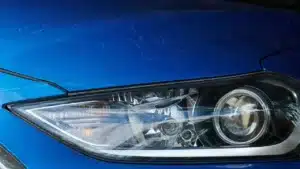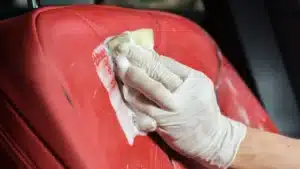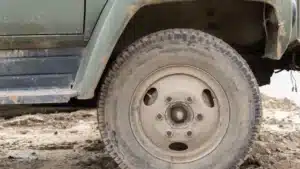Just another day and the inevitable happened, and now you are searching for how to clean perforated leather seats with ease. No worries, I have got you covered. We deal with this in our garage on a routine basis.
There are a bunch of different ways to have your perforated leather cleaned, depending on the kind of spill you are dealing with.
I will be covering all kinds of cleaning methods and you will surely find the exact one you are dealing with. And I will make sure to make it easy, with step-by-step procedures, and guide you with the products you will need along with it.
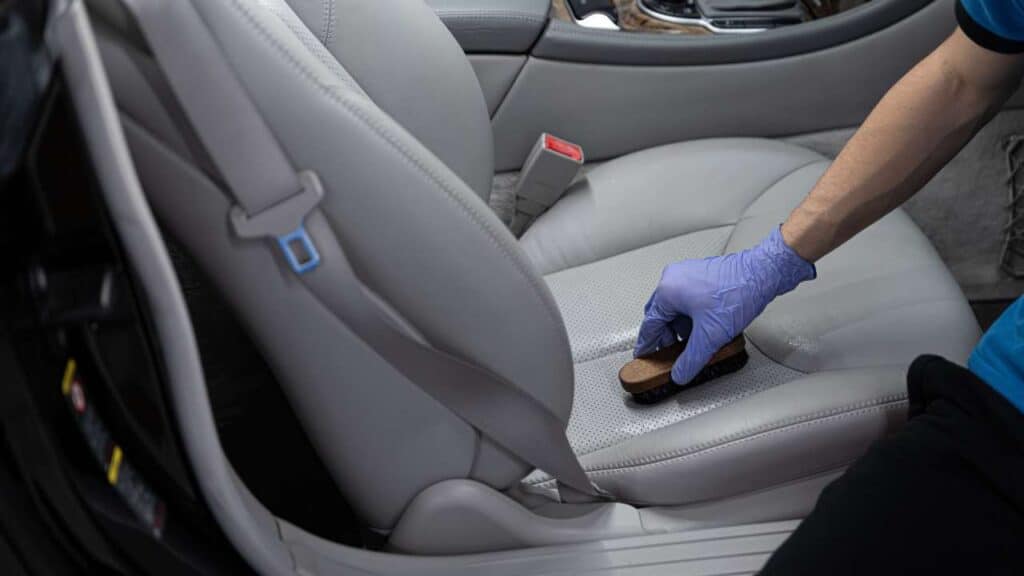
Required Materials for Perforated Leather Seats
Had your perforated leather seats been treated with the right products, the spill would have glided away from the seats and would have not seeped into the pores.
In this section, I will also list products that can help keep the spills away and make your leather seats last as long as possible.
- Cleaning Liquids — LEXOL (specific leather cleaner), P&S Express Interior Cleaner
- Microfiber towels
- Soft Bristled Brush
- Wet/dry Vacuum
- Hairdryer
- Steam cleaner
- Leather treatment
- Micro-size interdental cleaner
Make sure to follow all the precautions that I have mentioned along the procedures to avoid any mishap lest you end up damaging the perforated leather seats.
How to Clean Perforated Leather Seats?
Let’s get started with the cleaning method. I have divided the procedure into three basic steps.
- Step 1: Loosening the gunk and debris
- Step 2: Removing the gunk and debris
- Step 3: Final Finishing
First, you need some cleaning products that can help loosen up the dirt and debris from those pores. After that, you will need some tools and brushes to remove the stuck material from the pores and finally have the stuck material removed from the inside.
Just like leather cleaning, you might also face some trouble cleaning the regular upholstery of your vehicle where water stains are the biggest setbacks in the cleaning process. If you want to learn how to get water stains out of car seats, you can check this highlighted step-by-step guide.
Now back to the leather cleaning.
Step 1: Loosening the gunk and debris
The first step is to use a cleaning liquid for removing the surface dirt and grime. The area where you need to be careful is the product choice. By all means, get yourself some quality products and make sure not to fall for the cheaper options.
To let you know the rule of thumb in leather detailing — shiny does not mean good. You want a matt finish on your leather, which is the right finish. Shiny is just a cheap way of making the leather look good to a normal person but for a detailer like me, it’s an abomination.
Yes, you need oils for your leather, but those oils are meant to be absorbed by the leather, not shown.
Here are a couple of entry-level products that can give you good results for surface cleaning and removing all of that loose dirt from your perforated leather car seats.
- P&S Express Interior Cleaner
- Colourlock leather and textile cleaning brush and an alternative brush.
- Microfiber cloth (I recommend the white ones for leather, as the colored ones might get their colored dye stain the leather)
- LEXOL Cleaner and leather Conditioner for regular maintenance.
Procedure
- Spray the leather cleaner moderately on the perforated leather car seats and agitate with the brush in circular motions.
- Let the leather cleaner stay for a while on those tiny holes and wipe it with a clean microfiber towel
- Spray the leather cleaner again and brush the perforation holes at an angle to remove the debris from the nooks and crannies.
- Wipe it with a clean microfiber cloth
- Use a steam cleaner or heat gun/blow dryer to facilitate the process. You can also use an air compressor to blow compressed air.
This procedure is adequate for superficial cleaning, however, this might not work if the stain has been there for some time. For a hardened mess, you can resort to this next step that will help loosen up that gunk sitting there for ages.
How to loosen up the stuck material on your perforated leather car seats?
There are a couple of different ways you can loosen up the spill in case it has been there for some time, which means, a simple cleaning method won’t work, so before we can get to the deeper removal of the gunk, we need to perform a comprehensive softening of the stuck material.
I have highlighted the methods you can use to soften up the gunk and move on to the removal process.
- If you have heated seats, you can turn on the seat heating. As an alternative, you can also use a hair dryer (lowest setting). Make sure not to touch the hot dryer on the leather. You can wrap the hairdryer with a microfiber cloth, and dab the area where the material is stuck.
- A steam cleaner can also be used that will soften the hardened mess, but make sure not to throw steam directly onto the leather, and avoid directly touching the nozzle on the leather. You can wrap it around a damp cloth so you can avoid leather damage due to excessive heat.
Step 2: Removing the gunk and debris
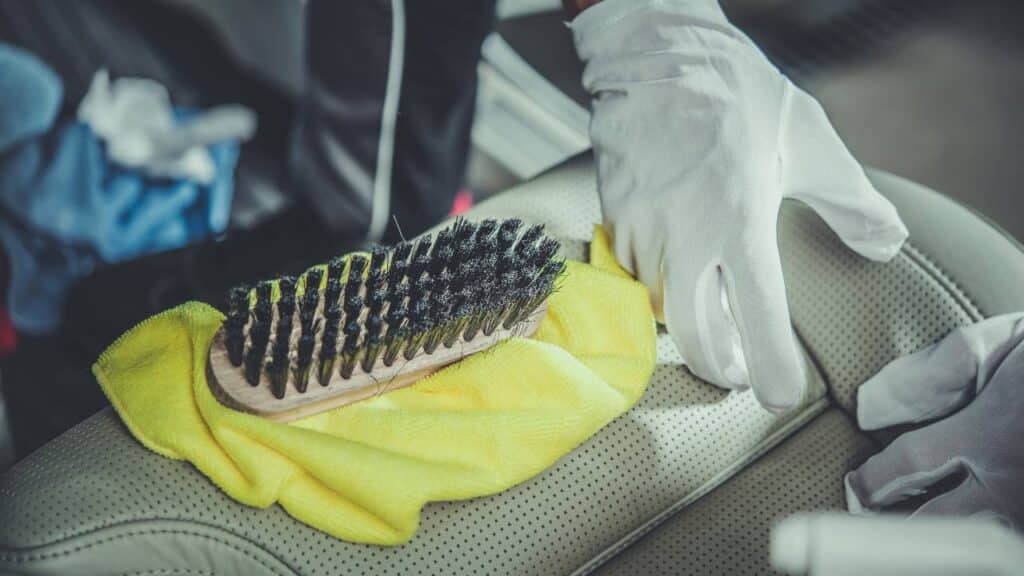
A vacuum with a smaller attachment (preferably automotive grade) is a great tool to get all the loose dirt and grime on top of the perforated leather car seats as well as from deep within.
- The water vacuum (dry/wet vacuum) would be the best option if you have one available. I would highly recommend the Mytee S-300H.
It will not only help you with the cleaning of your perforated leather seats but will also make it so much easier to clean your household items as well. - You can also use a cheaper alternative KOWASIS handheld vacuum, however, it won’t be as good as the Mytee S-300H.
Procedure
- The material that has seeped into the pores would require some agitation, for which you can use a wet/dry vacuum, preferably the Mytee S-300H, or the KOWASIS.
- Spray the leather cleaner moderately onto the pores and let it seep in.
- Use the wet/dry vacuum with the light setting, as to make sure the suction is not too harsh for the leather.
- Give it 4 to 5 passes. Might require more work depending on the amount of spill that has seeped in.
- If you are using a harsher chemical for cleaning a larger mess, you will have to work extra on the leather treatment later on.
- You can use a hair dryer to facilitate the drying process.
- Use a microfiber cloth and keep wiping the surplus liquid that comes out.
And this is how to clean perforated leather seats with ease like a pro. But the process is not complete yet. After this deep cleaning, you need to make sure to treat the leather seats, use a completely dry microfiber towel, and move on to the finishing step.
Important Note
If you don’t have a wet/dry vacuum at your disposal, you can use a normal vacuum along with the steam cleaner and hairdryer (lowest heat setting and not held too close to the leather).
The goal is to soften up the mess and dissolve it into the cleaning liquid and suck it out of the foam underneath. You can also wrap a damp cloth around the very thin vacuum nozzle.
Additional Tips
If the leather pores are clogged, you can use the micro-size interdental cleaner and unclog the perforated seats, and hopefully, you wouldn’t have to do this on the whole perforated leather car seats and only a small patch where the spill is.
Step 3: The Finishing Process
After you are done with all the cleaning and removing process, you are down to the last step which is the leather treatment. You don’t want to end up with dry leather.
There is a huge range of leather products available in the market that can do the job, however, you should always avoid the ones containing silicone solvents and wax-based products.
My recommendation for regular upkeep of your perforated leather seats would be the LEXOL leather cleaning spray and leather conditioner. You can apply leather conditioner before the sealant.
To seal all of that goodness, you can resort to Colourlock products. For relatively new leather, you should not use stronger chemicals, and the mild colourlock leather care set would suffice your needs.
Procedure
- Spray an adequate amount of high-quality leather conditioner equally on the whole surface and wipe it with the applicator pad.
- let it stay for a minute and then wipe it with a clean microfiber towel.
- To get a matt finish on your now clean perforated leather car seats, you can put on the colourlock cleaning products. The sealant is applied in the same manner as the conditioner, however, you only need a small amount.
- Distribute the product equally and wipe it down with a new microfiber towel, and that is how to clean perforated leather car seats with ease like a pro.
How to clean vomit out of perforated leather seats?

Cleaning vomit out is not much different than cleaning and removing any other spill from your perforated leather seats.
The only difference with vomit is the lingering smell that needs to be addressed, for which we will be using some extra cleaning liquid, and by the time you are done with the cleaning, you will have a nice and clean scented cabin.
Materials Required
Baking soda is not a good option to remove odor. Don’t perform your home remedies on these expensive perforated leather car seats, you may either void your warranty or you might end up paying a lot more $$$ on leather repairs.
I have seen people recommending weird stuff online to be used on the leather seats, which actually harms the leather seats.
Preferred Equipment
Steps
- Spray the leather cleaner onto the pores and let it seep in. The cleaning liquids that I have mentioned here will not damage the leather, so you don’t have to worry about using too much. You want the liquid to seep in and work its magic of removing the vomit from the foam inside.
- Agitate the liquid by using a soft-bristled brush in a circular motion and then at an angle to let the stuck material come out of the pores.
- Repeat this process a couple of times so no vomit is left visible on the surface.
- Now it’s time for the extraction. I would recommend using distilled water and you can use it in a ratio of 5:1 with woolite. Baby shampoo can also be used as it’s mild and would not damage the leather.
- Use the extractor (dry/wet) vacuum a couple of times to make sure that the cleaning liquid has reached as far as the vomit has reached to remove odor.
- After you are done with the extractor, you can use the steamer as well, however, don’t use it directly onto the pores. You can put a microfiber cloth on the nozzle and spray it onto the pores so it doesn’t get too heated.
- Use a normal vacuum (low setting) and suck any liquid that still remains.
- Dry with a microfiber towel and let it dry. You can open all doors and windows to let air flow through the interior.
- You can refer to my finishing process section where I have given details on how you can give protective treatment to your leather.
How Often Should You Clean Perforated Leather Seats?
The time interval for cleaning leather seats does not differ from any other regular fabric seats, however, you should pay extra caution to leather protective treatment because the right treatment can keep your leather looking as good as brand new.
Cleaning often with harsh chemicals can affect the matt finish of your leather, which will further reduce longevity in the long run.
Make sure to give the UV protection and oil treatment as well to avoid any cracking which is sped up due to heat and UV. The goal is to keep the leather from getting dry.
The basic oil treatment and sealant can help avoid the seeping of spills through the pores up to some extent.
If you are quick enough to wipe whatever the spill may be, you might get away with just a simple wipe and not have to deal with the strenuous cleaning process of removing the spill from the inside of the leather seats.
For relatively new leather (up to four years old), I would recommend the COLOURLOCK new leather care set that will give you the leather cleaner along with the leather sealing liquid.
If your leather is a bit old, you can use the relatively stronger COLOURLOCK cleaning kit.
For simple surface cleaning, I would recommend the P&S Xpress interior cleaner. For regular maintenance, you can also use the leather Cleaner and the leather Conditioner by LEXOL.
FAQ
Can you steam clean perforated leather car seats?
Yes, you can steam-clean perforated leather seats without a problem. It will not damage the leather, however, some automotive manufacturers recommend otherwise.
If you are dealing with a pesky stain that leaves you no choice but to use the steam cleaner, make sure to keep it at a distance and not directly put the nozzle onto the pores.
The moisture can, later on, be removed with the help of a vacuum on its low setting. When you are done with the cleaning, treat the leather with the polish and sealant and you will be good to go.
Are perforated leather seats worth it?
Perforated leather seats are best if you want something with better breathability. The biggest drawback when it comes to plain leather seats would be the heat retention.
Most vehicles that offer airconditioned seats will have perforated leather seats to facilitate air circulation making it much more breathable in hot weather.
Is perforated leather waterproof?
No, perforated leather is not waterproof, however, if the leather is treated right, the oils can repel some amount of water and prevent it from seeping into the pores. If the perforated leather is dry and not well kept, the water will seep right in.
Does perforated leather get dirty?
Yes, like any other leather, perforated leather also gets dirty and would require regular cleaning along with leather maintenance procedures.
However, unlike fabric which absorbs dirt, you wouldn’t have to fight with surface cleaning when it comes to perforated leather, it’s the deeper cleaning that becomes a hassle in perforated leather.
Conclusion
Perforated leather seats require regular upkeep just like any other leather seats, however, for cleaning perforated leather seats, you would have to do extra work to get the stuck inside mess out of those tiny holes.
I have given detailed instructions on how to clean perforated leather car seats with ease like a pro so you can also feel the satisfaction that comes after detailing cars.
For cleaning perforated leather seats, I would recommend the LEXOL leather cleaner and leather conditioner. For relatively clean leather seats, you can also use the simple P&S interior cleaner.
For the finishing touches, the COLOURLOCK would be your best option. Mild for new leather car seats, and the relatively stronger one for older leather car seats.
If money is not an issue, I would highly recommend using an extractor.

